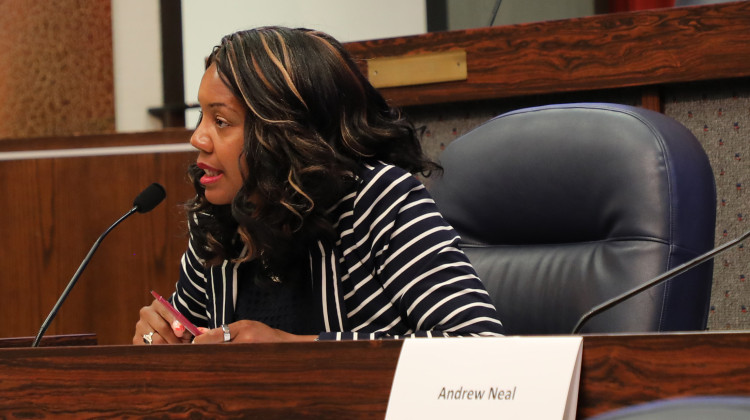
The state’s latest IREAD results show slightly higher passing rates for third-graders in most Marion County districts, but many are still well below the statewide average.
WFYI file photoThis article was co-published by Chalkbeat Indiana and WFYI as part of a partnership to increase coverage of township school districts in Marion County. Have a tip or story idea about a township school district? Email in.tips@chalkbeat.org and tips@wfyi.org or fill out this form.
The share of third graders passing the state’s IREAD literacy test rose slightly in most Marion County school districts this year, although none have returned to pre-pandemic rates.
The majority of Marion County districts and charter schools also remain well below the statewide pass rate of 81 percent for public school students.
Passing rates for Indianapolis Public Schools, the city’s largest district, declined from 62.8 percent last year to 60.6 percent this year. The rates for schools in Speedway, Perry and Franklin Townships also fell. Meanwhile, scores rose in seven other township districts, including Decatur, Warren, and Washington.
Proficiency rates for independent charter schools within or near Indianapolis Public School borders rose slightly as a whole, but are still far below their pre-pandemic pass rate of about 84 percent in 2019.
And charters within the IPS Innovation Network — which are run independently but are considered part of the district — also showed slight improvement overall.
The results for Indianapolis schools show the pandemic’s ongoing disruption to students in the early grades, which educators and others consider crucial for building students’ literacy skills.
Districts and individual schools that improved significantly from last year highlighted efforts like a local summer learning initiative, state-funded coaching for teachers, and embracing training in the science of reading, which emphasizes phonetic instruction and science-backed ways of learning.
“We really leaned heavily into the science of reading, given the number of second-language learners we have,” said Alicia Hervey, founder and executive director of the Path School at Stephen Foster School 67, an Innovation charter school where the IREAD passing rate jumped more than 13 points from last year to 35.8 percent.
IREAD scores for school districts across Marion County showed only slight increases or decreases, mirroring a stagnation in both the latest statewide IREAD and ILEARN results.
Among township school districts and IPS, Warren Township schools improved the most since 2022, increasing from 64.7 percent to 69.8 percent.
Ryan Russell, associate superintendent for Warren Township schools, said the district made K-3 literacy a priority last school year, focusing on training K-3 staff on the science of reading over the past three years.
All nine of the district’s elementary schools also participated in the state’s literacy coaching program, which guided the district’s own literacy coaches and teacher leaders.
But like all other school districts, Warren Township schools still have significant gains to make before reaching the district’s 78 percent passing rate of 2019. The biggest such gap is in Perry Township schools, where the gap between 2019 and 2023 IREAD scores is approximately 12 percentage points.
Russell said the district’s goal is to grow by 10 percent every year, reaching pre-pandemic levels at the end of this school year.
“We’re certainly celebrating our growth and we are happy to experience that growth, but at the same time we realize how critical of a measuring stick this is for our students and their future,” he said.
Independent charter schools in or near IPS boundaries continue to perform better than IPS as a whole, but also remain well below the statewide average.
The K-5 Ace Preparatory Academy, where the proficiency rate rose more than 14 percentage points to 76.3 percent, also participated in the state’s literacy coaching program to provide guidance for the school’s literacy coach.
Principal Amanda Liles also attributes the growth to the school’s small class sizes, its focus on student data, the skill and consistency of the school’s teachers, and an extended literacy-focused teaching period of 90 minutes.
“We’ve really been intentional about how we interpret our student data and how we help our scholars understand what that means for them as far as their growth,” she said.
Black students in independent charters for which disaggregated data was available had higher pass rates as a whole compared to Black students in IPS, with 67 percent of students passing. Data for some schools, however, wasn’t publicly reported by the state due to the small number of Black students taking the test.
The number of Hispanic and white students in many independent and Innovation charters was also too small to reach a firm conclusion about their success compared to their peers in traditional school districts.
Among all Marion County districts, IPS had the highest gap in the passing rate between white and Black students, with 52.6 percent of Black students passing compared to 83.9 percent of white students. The gap in IPS between white and Hispanic students is also the greatest of all the Marion County school districts, with 50.7 percent of Hispanic students passing the test.
But the IPS statement pointed to some “bright spots” from this year’s data, noting that eight schools outperformed the state average for Black students.
The district’s Emerging Schools, which are a set of low-performing schools, made gains that on average outpaced state gains, the district said.
The passing rate at IPS Innovation charters, meanwhile, increased as a whole from roughly 46 percent to nearly 51 percent. But at Innovation Restart schools, which are chronically underperforming schools that charter operators are trying to improve, there was significant variation.
Four schools’ scores dropped from last year’s passing rates: Global Prep, Phalen Leadership Academy (PLA) at Francis Scott Key 103, Adelante Schools at Emma Donnan Elementary, and Liberty Grove Schools at Elder Diggs School 42.
But there was sufficient improvement at the remaining four — the Path School, Urban Act Academy at Washington Irving School 14, Matchbook Learning at Wendell Phillips School 63, and PLA at Louis B. Russell School 48 — for the overall passing rate at Innovation Restart schools to rise.
The Path School required students who did not pass the IREAD in the spring to attend an Indy Summer Learning Lab that helped a few more students pass the test over the summer, Hervey said. The school also did after-school tutoring twice a week, she said.
Still, the school’s 35.8 percent pass rate is well below the 61.3 percent rate from 2018-19, two years before School 67 became a charter school. Hervey said the school’s goal is to reach a 95 percent pass rate.
“I do expect we’ll be around 80 percent over the next few years,” she said.
Amelia Pak-Harvey covers Indianapolis and Marion County schools for Chalkbeat Indiana. Contact Amelia at apak-harvey@chalkbeat.org.
Chalkbeat is a nonprofit news site covering educational change in public schools.
 DONATE
DONATE







 Support WFYI. We can't do it without you.
Support WFYI. We can't do it without you.